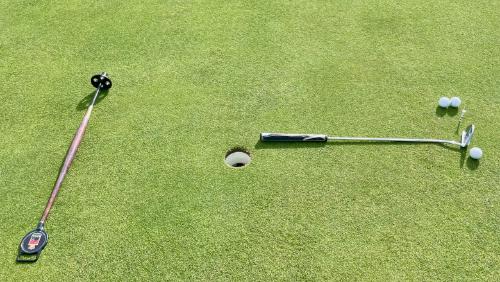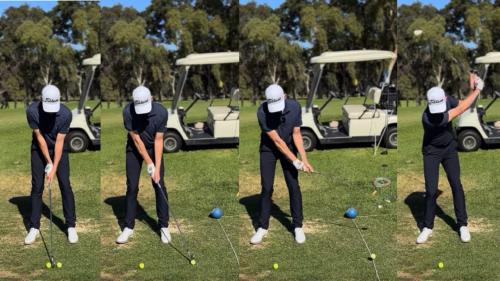Just over three weeks since my last golf update (other than mentions in weeknotes)…
…safe to say things have been a bit up and down (and back up again).
The weather has cooled with storms and rain threatening to impact (see image above, taken just before I drove to the Wednesday competition this week), but largely not affecting, my practice and competition play.
I had another lesson on Tuesday 8 April. I could tell that writing these notes (and sharing them with my coach) is helpful. We had a few things to discuss and then we spent some time on the range to (amongst other swing-related things) learn some strategies for how to manage myself and practice in that space, while also building some positive memories. (Given what happened the week before that was important.)
Things to think about:
I should have written about this last week! Here’s what I remember most clearly from our chat and the practice that followed on the day:
-
It is vital to set the body up properly and this is something I regularly don’t do carefully enough (in particular as I get tired, frazzled, hurried or down on myself). This is a bit difficult to explain in words (although I know what it feels like). Broadly, it’s about extending the spine, increasing space under the rib cage, while keeping the neck and head tall and in balance. I’ve been finding that if I follow my club placement process fully (see the checklists below) then I stretch and balance myself automatically. If I don’t, then I forget to think about how I’m standing. Hence - process is everything!
-
On the range (given time) work through the clubs and swing lengths. Always begin with your wedge. Then work up through longer clubs. In the lesson I worked from a putting stroke, via chipping, pitching and then full swing with all the clubs we picked.
-
Allow your head and shoulders to tilt and balance your backswing. Here’s where it’s important to realise that keeping an eye on the ball and your body in the shot (see below) doesn’t mean you need to keep your head and shoulders still in terms of tilt. While you don’t want to sway, you do need to execute a spiral twist: up, back down, then through.
-
Your arms will need to bend to allow the swing to work. There’s an element of keeping your arms extended through the swing, but it just doesn’t work if you try to lock your elbows. I try not to think about this at all, aiming simply to swing in a relaxed rhythm. Of course, I don’t always get this right, but overall I’m trying to be focused on relaxing and breathing before swinging easy. Tightness in my neck, shoulders and arms becomes an issue when my practice isn’t going well, making it worse. During a round I’ll get tight when I’m beginning to wonder what’s going wrong (again, the tightness will just make it worse). Sticking with the process and taking a breath helps reduce tightness and return to the rhythm I need.
Two weeks of issues with practice
After the lesson I found I still didn’t want to visit the driving range. My motivation was derailed. When I went to practice my short game (as a compromise with myself) even that didn’t go well.
I played ok competition golf, but there was a lot of scrambling to make up for a lot of poor shots. Then I tripped and bruised my hand, so I had a good excuse not to practice for a bit.
The next week I went back to working on my short game for a brief session before a pairs competition the next day (for which the result was better than our play deserved). I skipped my next practice session - motivation was low!
I tried some on course practice on my own at the weekend, but it didn’t go well… then I took D with me, and things got a bit more enjoyable! D noticed how much better I played when I stayed in the shot, versus looking for the result. I was determined to take this insight with me into my next practice session.
An additional thing to think about:
- Stay in the shot. Ok, so, the old saying - keep your head still - is counterproductive (as I note above); but not looking up too quickly to see what’s happened to the ball in flight helps you stay in the shot, keeping your eyes on, and your body over, the ball a little longer. This (and I can confirm from personal experience now) makes for better strike, direction and distance control. It’s only a moment - a golf swing is quick - but completing the action before looking for the result is key.
I find this particularly difficult on driving ranges, where I feel the need to look quickly in case it’s gone wrong directionally speaking and I need to shout a warning. The trouble is that looking up too soon makes it go wrong (often).
I sometimes look too soon on course too, in particular when I’ve been a bit wayward already, the sun is low and/or there’s noone else to watch where I’ve gone (or I’m getting the sense people with me might not be looking).
A week of more positive experiences
When I turned up to practice the next time I went straight to the range. Everything was so much better than the previous week! I was focused on being in the shot. I was hitting things more solidly and more often in the right direction.
I was going to do some short game work when I bumped into my coach. This resulted in more range balls and a great short lesson (for free)! Some of our time was spent improving how I hit my 28-degree hybrid (up to now my mystery club, because I never knew when to use it). The major takeaway…
Another additional thing to think about (!):
- Check the club face orientation pointing towards your target. After you’ve setup to take a shot, lift the club and turn towards your target (relaxed arms holding the club just ahead of you pointing in the direction you want the ball to go). How is the club face oriented? Mine is sometimes (and it used to be always) closed - ie tipped left - and I want it to be vertical. Adjust the handle as required - ie move the club handle in your grip, don’t twist yourself to make it look right (!!) - return to address the ball and take your shot (without changing anything else). Probably not the best explanation, but I’ve got this working pretty well now I’ve managed to incorporate it into my process.
Process is everything
The day after my not-a-lesson (wasn’t that a lesson?) I played an ok round of golf. Some bad shots, some really excellent ones, more scrambling to make a score. My 28-degree hybrid suddenly made sense! I hadn’t incorporated what I’d learnt into my process effectively enough - sometimes I got it, but other times I lost it.
My next practice session was somewhat the same, because I hit about half a large bucket of balls before I remembered to stay in the shot…! I forgot other things too! I regrouped and worked on a process that I could use for practice and also take out to the course.
Given I seem to forget to do things while practising and playing I’ve written myself some checklists. I can review these before I practice or play… maybe they’ll help!
Range checklist:
Work from wedge up. Do not skip the wedge!
Check target, choose alignment point in front of ball.
Setup:
- Use right hand to hold the club, hand over the handle, index finger pointing down the grip
- Extend back and ribcage with balanced shoulders, neck and head
- Align the club face with alignment point
- Grip the club
- Comfortable foot position
- Lift and move the club face towards the target to check orientation, adjust grip if necessary
- Return to address the ball
(Note: I find that using my right hand as described above to setup immediately means I begin to extend my back etc, I don’t know why.)
Swing!
Allow your head to move as a counterbalance to the swing.
Keep your eye on the ball, look but not too soon.
Trust the process.
Trust your swing.
Pay attention and consider a PAD analysis.
Issues? Work from chip via pitch to full shot for each club.
Course checklist:
Check target, choose alignment point in front of ball (consider how lie will affect the shot).
Practice swing (similar lie to ball).
Setup:
- Use right hand to hold the club, hand over the handle, index finger pointing down the grip
- Extend back and ribcage with balanced shoulders, neck and head
- Align the club face with alignment point
- Grip the club
- Comfortable foot position (again, consider lie and angle)
- Lift and move the club face towards the target to check orientation, adjust grip if necessary
- Return to address the ball
Swing!
Allow your head to move as a counterbalance to the swing.
Keep your eye on the ball, look but not too soon.
Trust the process.
Trust your swing.
Next shot!
Anzac Memorial Runner-up
All power to the person that won! We had just been discussing our difficulties with golf earlier in the week, so I’m very pleased we both played to our handicaps. She pipped me to the win on a countback.
My process was excellent. I had some mishits, which is to be expected as I keep working with my new grip and the way it makes my swing feel. Each time I hit a poor shot I rallied and recovered well. My chips and pitches were very good. My driving was good (most of the way around). My putting was solid.
I’ve got some time to keep working on all this before my next lesson - but not much time!




